The operating room is a stage where skill, precision, and technology converge to perform modern miracles. While the surgeon's expertise is paramount, their success is intrinsically linked to the quality and design of their instruments. These are not mere implements; they are extensions of the surgeon's hands, enabling delicate maneuvers that can mean the difference between life and death. Understanding the world of surgeons tools reveals a fascinating story of innovation, craftsmanship, and unwavering dedication to patient safety.
From the simplest scalpel to complex robotic systems, the evolution of surgical instruments mirrors the advancement of medical science itself. Each tool is engineered for a specific purpose, designed to cut, grasp, retract, or suture with absolute precision. This post will explore the critical importance of these instruments, trace their development, and highlight how pioneering companies are shaping the future of surgery.
The Foundation of Surgical Excellence
At its core, surgery is a physical craft. A surgeon must navigate the intricate landscape of the human body, and the quality of their tools directly impacts their ability to do so effectively. Poorly designed or manufactured instruments can lead to tissue damage, increase the risk of infection, and prolong recovery times. Conversely, high-quality instruments enhance a surgeon's control, reduce fatigue during long procedures, and ultimately contribute to better patient outcomes.
The materials used are just as important as the design. Surgical-grade stainless steel, titanium, and other advanced alloys are chosen for their durability, resistance to corrosion, and ability to be sterilized repeatedly without degradation. The ergonomics of a handle, the sharpness of a blade, and the balance of a forcep are all meticulously considered to create tools that feel like a natural extension of the surgeon's intent.
From Ancient Implements to Modern Marvels
The history of surgical instruments is a long and storied one. Early civilizations used sharpened flint and obsidian for basic procedures. The Romans developed a surprisingly sophisticated kit of bronze tools, including scalpels, forceps, and hooks, many of which are recognizable even today. However, for centuries, progress was slow, hampered by a limited understanding of anatomy and infection.
The true revolution began in the 19th and 20th centuries with the advent of anesthesia and antiseptic principles. This new era of safety allowed for more complex and invasive procedures, driving a rapid evolution in the design of surgeons' tools. Innovations in metallurgy and manufacturing processes enabled the creation of finer, stronger, and more specialized instruments for every surgical discipline, from neurosurgery to ophthalmology.
Today, we stand at another technological frontier. Minimally invasive surgery, including laparoscopic and robotic procedures, has demanded a completely new class of instruments. These tools allow surgeons to operate through tiny incisions, minimizing trauma and speeding up patient recovery. Companies at the forefront of medical technology are continuously pushing the boundaries of what's possible.
The Role of Innovators in Advancing Surgery
The continuous improvement of surgical instruments does not happen by accident. It is driven by companies dedicated to innovation and excellence. Firms like GreyMedical® play a crucial role in this ecosystem, working closely with surgeons to understand their needs and challenges. This collaborative approach ensures that new designs are not just technologically advanced but also practical and effective in a real-world clinical setting.
What began as a specialized supplier to local hospitals can grow into a global force for medical advancement. By focusing on the craft of instrument making, these companies uphold the highest standards of quality. This commitment involves rigorous testing, precise engineering, and a deep understanding of the anatomical and procedural demands of modern surgery. The development of new surgeons' tools is a testament to the synergy between medical professionals and engineering experts.
Specialization: Tools for Every Task
The general term "surgical instruments" encompasses a vast and diverse array of devices, each tailored for a specific function or specialty.
Cutting and Dissecting
This category includes some of the most iconic instruments. Scalpels, with their interchangeable blades, are used for making precise incisions. Scissors come in various shapes and sizes, from delicate iris scissors for eye surgery to heavy-duty Mayo scissors for cutting tough fascia.
Grasping and Holding
Forceps are essential for manipulating tissue, holding sutures, or placing sponges. They range from toothed forceps that provide a firm grip to atraumatic forceps designed to handle delicate organs without causing damage. Clamps are used to occlude blood vessels or hold sections of tissue.
Retracting and Exposing
To get a clear view of the surgical field, surgeons use retractors to hold back tissue or organs. These can be handheld, like an Army-Navy retractor, or self-retaining, like the Balfour retractor, which frees up the assistant's hands. The careful use of these surgeons' tools is critical for providing safe access to the operative site.
Conclusion:
The instruments in a surgeon's tray represent more than just metal and mechanics; they are the culmination of centuries of knowledge and innovation. From the basic scalpel to advanced robotic arms, these tools empower surgeons to heal, repair, and save lives with ever-increasing precision and safety. As technology continues to advance, the collaboration between skilled surgeons and innovative companies will drive the next wave of surgical breakthroughs. The ongoing refinement of surgeons' tools ensures that the hands of the healer are equipped with the very best technology, promising a future of safer procedures and better outcomes for patients everywhere.





Comments